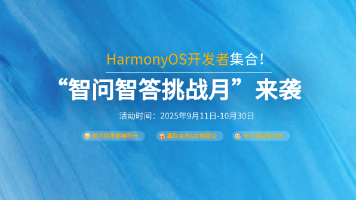#跟着晓明学鸿蒙# 社交应用发现和我的页面实现
·

案例介绍
本教程将介绍如何实现社交应用的发现和我的标签页内容。我们将实现发现列表和个人中心的布局和样式,为用户提供功能入口和个人信息展示。
代码实现
@Entry
@Component
struct BadgeTabContentExample {
// 模拟发现数据
private discoveries: Array<{
title: string,
isNew: boolean
}> = [
{ title: '朋友圈', isNew: false },
{ title: '扫一扫', isNew: false },
{ title: '游戏', isNew: true },
{ title: '小程序', isNew: false },
{ title: '直播', isNew: true }
]
build() {
Column() {
Tabs({ controller: this.tabsController, index: this.currentIndex }) {
// 发现标签页
TabContent() {
List() {
ForEach(this.discoveries, (discovery) => {
ListItem() {
Row() {
Text(discovery.title)
.fontSize(16)
.fontWeight(FontWeight.Medium)
if (discovery.isNew) {
Text('NEW')
.fontSize(10)
.fontColor('#FFFFFF')
.backgroundColor('#FF0000')
.borderRadius(10)
.padding({ left: 6, right: 6, top: 2, bottom: 2 })
.margin({ left: 8 })
}
Blank()
Image($r('app.media.arrow_right'))
.width(16)
.height(16)
.fillColor('#999999')
}
.width('100%')
.padding({ left: 16, right: 16 })
.onClick(() => {
// 点击发现项时,将其标记为非新内容
discovery.isNew = false
// 更新徽标
this.updateDiscoveryBadge()
})
}
.height(56)
})
}
.width('100%')
.height('100%')
.divider({ strokeWidth: 1, color: '#F1F3F5' })
}
.tabBar(this.TabBarWithBadge(2))
// 我的标签页
TabContent() {
Column({ space: 16 }) {
// 用户信息
Row({ space: 16 }) {
Stack() {
Text('我')
.fontSize(20)
.fontColor('#FFFFFF')
}
.width(64)
.height(64)
.backgroundColor('#0A59F7')
.borderRadius(32)
.justifyContent(FlexAlign.Center)
Column({ space: 4 }) {
Text('我的用户名')
.fontSize(18)
.fontWeight(FontWeight.Medium)
Text('查看个人主页')
.fontSize(14)
.fontColor('#666666')
}
.alignItems(HorizontalAlign.Start)
}
.width('100%')
.padding(16)
// 功能列表
List() {
ListItem() {
this.ProfileItem('我的收藏')
}
ListItem() {
this.ProfileItem('我的钱包')
}
ListItem() {
this.ProfileItem('我的相册')
}
ListItem() {
this.ProfileItem('设置')
}
}
.width('100%')
.divider({ strokeWidth: 1, color: '#F1F3F5' })
}
.width('100%')
.height('100%')
}
.tabBar(this.TabBarWithBadge(3))
}
}
}
// 个人中心功能项
@Builder
ProfileItem(title: string) {
Row() {
Text(title)
.fontSize(16)
Blank()
Image($r('app.media.arrow_right'))
.width(16)
.height(16)
.fillColor('#666666')
}
.width('100%')
.height(48)
.padding({ left: 16, right: 16 })
.justifyContent(FlexAlign.SpaceBetween)
}
}
代码详解
1. 发现列表实现
List() {
ForEach(this.discoveries, (discovery) => {
ListItem() {
Row() {
Text(discovery.title)
if (discovery.isNew) {
Text('NEW')
.backgroundColor('#FF0000')
}
Image($r('app.media.arrow_right'))
}
}
})
}
发现列表特点:
- 简洁的列表布局
- 新内容标记显示
- 箭头指示交互
- 统一的高度设置
2. 个人信息实现
Row({ space: 16 }) {
Stack() {
Text('我')
.fontSize(20)
.fontColor('#FFFFFF')
}
.width(64)
.height(64)
Column({ space: 4 }) {
Text('我的用户名')
Text('查看个人主页')
}
}
个人信息特点:
- 大尺寸头像
- 用户名显示
- 个人主页入口
- 合理的间距
3. 功能列表实现
@Builder
ProfileItem(title: string) {
Row() {
Text(title)
.fontSize(16)
Image($r('app.media.arrow_right'))
.width(16)
.height(16)
}
.height(48)
}
功能列表特点:
- 统一的列表项
- 箭头指示样式
- 固定的高度
- 居中对齐布局
4. 新内容标记
if (discovery.isNew) {
Text('NEW')
.fontSize(10)
.fontColor('#FFFFFF')
.backgroundColor('#FF0000')
.borderRadius(10)
.padding({ left: 6, right: 6, top: 2, bottom: 2 })
}
标记特点:
- 醒目的红色背景
- 圆角样式设计
- 合适的文字大小
- 适当的内边距
总结
本教程展示了如何实现社交应用的发现和我的标签页内容。通过合理的布局设计和统一的样式处理,我们创建了功能丰富的界面。重点关注了功能入口的展示和个人信息的布局,为用户提供了便捷的功能访问体验。
更多推荐
 已为社区贡献100条内容
已为社区贡献100条内容







所有评论(0)